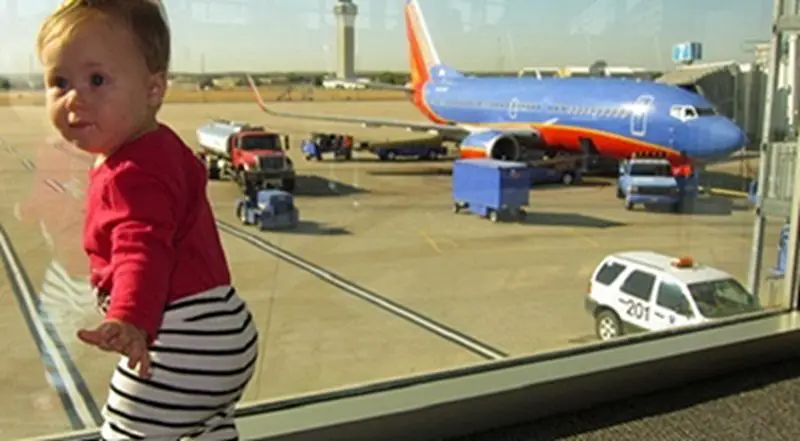
Its fun to be with kids, but most parents constantly worry about how to handle them when travelling. After all, there have been instances in the past when families were asked to get off the airplane because of unruly kids, and there’s always the never-ending debate over “family sections” on flights.
So if you’re planning to fly with a baby, it helps to be prepared. Not only it keeps you relaxed, you also make your co-passengers comfortable on the flight.
Here’s a Survival Guide on how to air travel peacefully with Babies and Toddlers on board.
Be it for a vacation or visiting relatives, these tips will prepare you for air travel with infants and toddlers. Most moms are aware that a well-fed, well-rested, and comfortable baby is usually a quiet and happy one, and that’s indeed true. Here are few more things that you need to take care of.
Make Sure the Baby is ‘Well Fed’ on the Flight
If your flight times are close to feeding times, try feeding your child in the flight, as eating on a plane has other benefits for tiny travelers.
Babies have narrower Eustachian tubes, and changes in cabin pressure during take-off and landing can cause extra pain for them. Swallowing helps relieve the pressure, and that can come in the form of nursing, a bottle, or a pacifier. If your baby is a lap infant, they are supposed to be held in the burping position during these times, but you can certainly breastfeed in this position.
Either feed your baby or give her a pacifier during takeoff and landing; the sucking will prevent the buildup of pressure in the ears.
When traveling with a baby under two, you are exempt from carry-on liquid restrictions. Keep all of baby’s food and drink together in an insulated bag so it’s easy to show for security inspections, and use frozen puree instead of ice packs to keep it all cool. In case of delays, bring at least two more meals than you think you will need. Before your trip, get baby used to room temperature food and bottles — it will save you the hassle of heating while you’re en route.
Do Not Disturb their Sleeping Patterns
Try to book flights around nap times, as the vibrations of a plane usually help babies to go off to sleep easily. If that’s not possible, book flights when they’re typically most cheerful (usually mornings). For red eye flights, bring pajamas on board and follow your usual bedtime routine as best you can.
Some Nutritionist’s recommend a snack of oatmeal and milk to help induce sleepiness.
If you do decide to try tranquilizing with anti-histamine or an anti-nausea medication, be careful; it may have the opposite effect and make your child hyper and irritable instead of drowsy. Before using any medication, consult with your doctor.
Getting Around
Most Aviation agencies strongly recommend that you purchase a seat for your baby, which means you will also need to bring on board an FAA-approved car seat. But for lap infants, each airline has its own policies regarding baggage and gear. Make sure you double check with your carrier about gate-checking strollers and car seats, and if you are allowed to bring an additional diaper bag on board. Choosing a family-friendly or baby-friendly airline can make your life easier.
Bringing a stroller/travel system is always a good idea, as some of them can be very versatile. Including a soft carrier or sling means your stroller can also work as a trolley. You will not be allowed to wear your baby during take-off and landing, but a carrier or sling will keep your baby close and your hands free during your flight.
You need to be careful when raising and lowering the armrests between seats, as they can severely pinch or cut little fingers and toes.
Vaccination
Family gatherings and airplanes are very likely places for your baby to get sick, so make sure your little one has received the first set of vaccines. Check with your Pediatrician as to what vaccines need to be given.
For Travelers without Babies
Check the seating plan and try to get a seat that is not next to a bassinet.
In case you wished to be moved, a polite request to the cabin crew should be the way to do it, rather than cursing (you might be one of “those people” yourself one day).
Parents describe their inflight woes, troublesome time from 35,000 FEET, with their little ones:
- My 18 month old screamed the whole 2.5 hour flight to Spain, it was our first time abroad with her and by the time we landed at our destination I just burst into tears and wanted to go home.
- People giving me bad looks for breast-feeding – even though I was covered up!
- On the journey home when my baby was 14 months old she suffered with terrible ear problems. She cried from the moment we too off to the moment we landed. A few parents came and offered me a hug due to the stressful flight we had had.
- My baby screamed when he had to hand over his juice to go through security.
- Having to fold the buggy down at the gate while simultaneously holding the baby and luggage.
- Having to stand and wait on other passengers in the toilet while holding baby with a soiled nappy, only to find yourself in the tiniest space to change the nappy in.
Anecdotes volunteered by survey respondents, supplied by Hippychick
Final Thoughts
That’s all to it really! Keep these suggestions in mind, try to get organized before everyone else boards the flight, and you should be okay on the flight with your little one.





